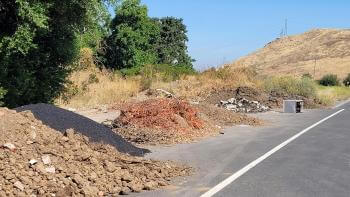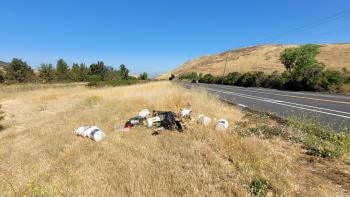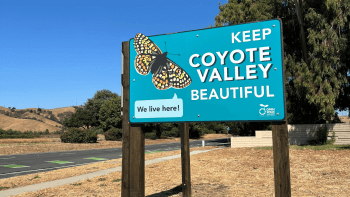The Negative Impacts of Illegal Dumping
While driving down San José’s Santa Teresa Boulevard, it’s likely one may see golden fields, farmland and maybe even a coyote or two. Unfortunately, it’s also likely that one may see piles of trash, broken household appliances, discarded mattresses and construction debris.
Illegal dumping, or the inappropriate disposal of unwanted items and hazardous waste, is a persistent issue that negatively impacts both the wildlife in your preserves as well as the surrounding environment.

As an agency that works to protect your open spaces, it’s often disheartening to see garbage bags and metal fragments, among other materials, littered on the edges of these beautiful places. Not only does illegal dumping decrease the area’s natural beauty, but it also negatively impacts the local environment and wildlife who call this space their home. Learn more about how illegal dumping is harming people, the environment and wildlife:
People
When household items are disposed of in an inappropriate manner, they run the risk of leaking hazardous materials and contaminating the air, water and local food systems and negatively affecting the public’s health. In addition, trash entices rodents and insects which may carry diseases that could be passed along to humans.

The Environment
When undesired items are discarded on the side of the road or in other unsuitable places, the environment both looks terrible and is impacted on a deeper level. Depending on the size of the disposed items, they may blow away into nearby water systems including streams and storm drains. As a result, the life of fish and other aquatic animals are at-risk.
In addition, illegal dumping can increase the severity of natural disasters. Trash left next to brush may be at higher risk of catching on fire if a wildfire were to break out, thus causing chemicals to be released into the environment, further exacerbating the fire and negatively impacting humans and wildlife. Meanwhile, larger items like furniture and old appliances thrown to the wayside may be likely to block storm drains and increase the likelihood of flooding during extreme wet seasons.
Illegal dumping has an adverse effect on the environment. When dirt piles are dumped in sensitive habitats it can introduce invasive plants, pathogens, or hazardous materials to once pristine lands. Sometimes it can cost thousands of dollars to clean up depending on what the lab results find in the soil samples.
Wildlife
While over 1.8 million people call Santa Clara County their home, it’s also important to remember that millions of insects, amphibians and other forms of wildlife do too! When residents dump their garbage and other items in places not meant for disposal, it causes a great issue for animals like coyotes, bobcats and mountain lions.
Wildlife are likely to ingest chemicals and foreign substances or get tangled up or injured from discarded debris. In addition, fish are at risk of dying due to things like fertilizer and trash polluting their water sources.

Keep Santa Clara Valley Beautiful!
Residents who need of a safe way to dispose unwanted items have access to the following resources:
💚 BeautifySJ: This free resource offers San José residents with the options to schedule free junk pick ups and report illegal dumping and graffiti sightings. Download the San José 311 app to begin!
💚 Volunteer for a local clean up group! Many districts within Santa Clara County have their own neighborhood clean up crews that work together to collect trash found on the street and dispose of it in a proper manner. We also suggest checking out Keep Coyote Creek Beautiful for clean up opportunities at local trails and creeks!
💚 Report Illegal Dumping: Each city in Santa Clara County has its own phone number to report illegal dumping. If you see trash or unwanted items disposed in an inappropriate manner, check out this list to report the issue to your city.
💚 Schedule a Pick Up with Recology: Some Santa Clara County residents who have their trash picked up by Recology can request an additional TWO pick ups per year for unwanted household items, debris and yard waste. Learn more here.